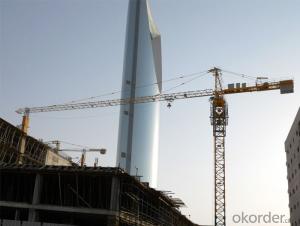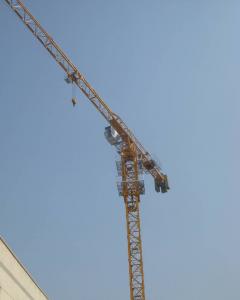Tower Crane Famous Chinese Factory Manufature
- Loading Port:
- China main port
- Payment Terms:
- TT OR LC
- Min Order Qty:
- 1 unit
- Supply Capability:
- 30 unit/month
OKorder Service Pledge
OKorder Financial Service
You Might Also Like
Structure of Tower Crane Description
Feature: Tower Crane Condition: New Application: Construction Max.Lifting Load: 10T Max Tip Load:1.6T Independent Height:50.5M
Max Lifting Height: 200M Span: 60m Certification: CE,ISO
Place of Origin: China(Mainland) Model Number: TC6016
Packaging & Delivery of Tower Crane
Packaging Detail: Nude package Delivery Detail: 25-30days
Main Feature of Tower Crane
● Max. working range 60m, tip lifting weight 1.6T and Max. lifting weight 10T.
● Slewing mechanism and trolleying mechanism equipped with VFD technical control, stable and reliable,can provide stepless speed regulation.
● Outstanding in working efficiency, operating speed and stability. Reduce future maintenance cost.
Tower Crane TC6016 Specifiction



FAQ of Tower Crane
Q: What kinds of tower crane are available now?
A: Four main categories: normal tower crane with cat head, internal climbing tower crane, top less tower crane and luffing tower crane.
Q: What kind of steel used for tower crane?
A: Normally, as for the main force bearing steel structure, Q345B is adopted; as for the assistance force bearing steel structure Q235B is adopted. All of the raw material is outsourced from qualified steel factory in China.
Q: Your tower crane is similar to Potain or Liebherr type?
A: We could develop any type of tower crane as per clients’ requirements if the clear information is provided. Originally, our tower crane design is based on Liebherr; but now, we not only introduced Potain design; but also developed special tower crane according to the market needs such as TC5013A with panel mast section. In addition, we also produce some models same as Potain original model, such as F0/23B, H3/36B and etc.
- Q: ok, how do you make a paper crane. i've totally tried with a direction and marked paper, but that didn't work out. by the time i gave up the paper was all smooth cuz it was so worn. anything would help, links, step-by-step instructions, both. whatever. 10 pts to whoever tells me, and i succeed. sweet
- wow, you must be refering to origami I can not help with this one but you can go to the library tomorrow and look it up (NOTE: this is neither joke or riddle see if there is a more appropriate place for this like arts and crafts )
- Q: if someone have formula for that, one telescopic crane is lifting and i know about the boom lenght and redius,then how i can calculate the angle,if crane crane angle indicator is not working.thankyou.
- You can figure out your angle with the Pythagorean method. Also, you should NEVER operate a crane with any indicator device not functioning. This in violation of OSHA law and many state and local laws. If there is any damage or injury you will be held negligent..
- Q: why do siberian crane migrate in india?
- The Siberian Cranes nest in western Siberia . During Winter season in Siberia , they migrate to India which is their wintering ground.The migration route stretches for 4000 miles. Their resting place at the time of migration is the Lake Ab-i-Estada in Afghanistan. The Kaladeo Ghana National Park or the Bharatpur National Park has been declared a world heritage site because the Siberian Crane traverses nearly half of the globe to reach it. The Siberian Crane is presently an endangered species. Larger numbers of birds have been hunted down over the years especially when they undertake the perilous journeys across the Himalayas to reach the wet land. They are shot down in Pakistan to be gifted to friends and relatives. This has led to a severe decline in the number of Siberian Cranes in the world. The immediate need of the hour is to provide safety to the Siberian cranes along their migration route. This popular visitor has not been seen in the last two years in India. The last pair of Siberian Cranes which had made the Bharatpur Bird Sanctuary their seasonal home in the year 2002 was not seen in the year 2003. Their absence is indeed painful and one of the aims of the Crane foundation is to bring back the Siberian Crane to India.
- Q: Do cranes, the bird, have any significance in Egyptian or Chinese mythology?
- Yes, they do. Look it up over an Internet search engine.
- Q: i need six colors mentioned in the story and wat each one means thanks :)
- From: The Open Boat By Stephan Crane. These waves were of the hue of slate... ...save for the tops, which were of foaming white... In the wan light, the faces of the men must have been grey. ...the color of the sea changed from slate to emerald-green... ...wild with lights of emerald and white and amber. ...near patches of brown seaweed... ... at the men with black bead-like eyes. ... marked by dingy clouds, and clouds brick-red, ... Ain't they peaches? A faint yellow tone came into the sky over the low land. ... a small bluish gleam on the edge of the waters. ... with a sky of pure blue...
- Q: what does dog everything mean in crane lift lingo?
- it means to stop the crane from doing anything, just sit still untill otherwise told to carry on
- Q: What does the crane mean to the Korean people?
- The crane mates for life. Most birds do not and very few mammals. So it is a symbol of fidelity and faithfulness or loyalty to one's chosen mate. They are also very long-lived, up to 70 years in captivity, and so are symbols also of longevity. See nationalzoo.si.edu/Animals/Birds/...
- Q: Where do Cranes (the bird), typically live in ohio?
- Are you referring to Sandhill Cranes? They may be migrating through Ohio right now on their way south.
- Q: how do construction crews put up a crane?
- They assemble it on a concrete foundation using a mobile crane. To grow taller, the top unit of the tower crane has a jacking mechanism that lets it raise itself up and insert another tower section.
- Q: I am 15 years old and into urban exploration. The only thing I haven t done yet is climb a crane. I don t want a big lecture on the dangers because I am fully aware of how dangerous it is and am also fully confident in my abilities. I am also ready to take full responsibility if I were caught. Although I know its Illegal, I don t know how Illegal it is and I would like to know the following...1. Will Crane Climbing get me charged with criminal trespassing?2. Will I get time in Juvenile?3. Is it possible that I could accidentally activate/deactivate something that would endanger the workers?4. What would happen if a worker got ahold of me?And again I feel like I need to mention that I don t want a Bull **** lecture on it not being safe. :)
- It's quite illegal. The penalties will be severe. That's nice you think you take responsibility. When you fall and injure yourself, you will not have the money to pay your medical bills, including your years on life support in a coma, etc. You'll be dumping that responsibility on everyone else. You do not just magically take responsibility by saying you do.
Send your message to us
Tower Crane Famous Chinese Factory Manufature
- Loading Port:
- China main port
- Payment Terms:
- TT OR LC
- Min Order Qty:
- 1 unit
- Supply Capability:
- 30 unit/month
OKorder Service Pledge
OKorder Financial Service
Similar products
Hot products
Hot Searches
Related keywords






























